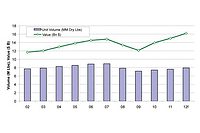STRATEGIC SOLUTIONS: The Internet, Secondary Research and Adhesives

As a consulting firm, The ChemQuest Group relies on secondary research as the foundation upon which to conduct primary research. The Internet has transformed how we do secondary research. A few years ago, secondary research meant having to search through abstracts and research articles, and copy the information on a copy machine. Today, we have the ability to do much more through the convenience of a broadband connection to the Internet.
Much of my work deals with understanding a number of value chains for the adhesives industry from raw materials to the end users. Information pertinent to the adhesives industry is by and large not the type of data that is easily obtained through the Internet. The Internet may be great for comparison shopping or researching the best digital camera to buy, but when it comes to areas of less general interest, there is a corresponding drop in the amount of useful information out there.
Therefore, I have evolved a systematic approach that functions in two ways. First, it keeps me informed on a daily basis for industry and corporate news. Second, it allows me to generate ad hoc secondary research for projects that require them.
For basic up-to-date information, set up a personalized homepage such as My Yahoo! It should contain a portfolio of public firms in the industry as well as industry news. It should also include firms and news from industries that directly affect the use of adhesives. For example, what news from the automotive or aerospace industry could impact adhesives usage? Think through the information that has a direct impact on your business and keep track of it. This includes alternative products and technologies that could impact current usage trends.
The second part of successfully conducting secondary research through the Internet is the ability to conduct searches on a specific topic that generate the information you are looking for in an efficient manner. It is often too easy to get into the habit of typing in a few keywords in different search engines to see what is available; this is not the way to do effective secondary research in this industry. It usually results in time being wasted looking at items that are not relevant.
The keys to successfully navigating the new research opportunities the Internet allows are the following.
- Understanding what data is available
- Understanding where the data is likely to be found
- Searching through appropriate search engine databases
The Internet provides enormous amounts of both quantitative and qualitative information that can be either free or fee-based. Examples of free data include homepages of corporations, white papers, newswire articles and press releases. Government databases are also free and are a rich source for data. Corporate filings with the Securities and Exchange Commission, patent and trademark filings, census data, production, output, inflation, housing, and construction can all be found there. Good starting points for federal government data include fedstates.gov and firstgov.gov. Although the United States leads the way in government data on the web, a number of other countries (particularly in the European Union) also have data available.
There are also a number of private databases that generally contain more effective information than free sources. Thomson Corp. and Reed Elsevier are the two largest information providers through their subsidiaries, including DIALOG, Thomson Financial, and Lexis-Nexis. These databases offer an extensive collection of material ranging from Wall Street analyst reports to full-text technical journal articles. Although these are subscription-based services, other websites like Northernlight.com allow the purchase of articles and reports on an individual basis. Additionally, check with a local library to see if they offer access to private databases. Our local library has a number of databases available for free (including Thomson Corp.'s InfoTrac) that can be remote accessed by anyone with a library card.
With an understanding of the available information there remains a question: which databases will have the information sought, and how to search those databases once there? One way to deal with locating the best places to search is indexing sites in "My Favorites" on a computer. Indexing with appropriate titles and folders can make navigating them much easier.
When searching a database, understand how the search works. Using the correct keywords and following search rules are crucial steps in finding the right information. Generally, each search engine has instructions on how to conduct a search, with an explanation of the rules that govern the search.
Ideally, you would be able to find whatever information you wanted through the Internet. However, that is not always the case. What you can do, though, is empower yourself to do effective secondary research on the Internet in order to better understand what is there, where to find it and when to look to primary sources (interviews) to answer questions.

For more information, contact The ChemQuest Group Inc., 8150 Corporate Park Drive, Suite 250, Cincinnati, OH 45242; phone (513) 469-7555; fax (513) 469-7779; or visit http://www.chemquest.com .
Looking for a reprint of this article?
From high-res PDFs to custom plaques, order your copy today!




